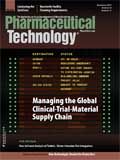Growth for Small Pharma
Small drug companies with hopes of achieving $1 billion in sales can pursue various strategies.
With advances in areas such as novel therapeutic areas, genomics, and personalized medicine, and growth in generic drugs, there are opportunities in the global pharmaceutical market. In existing and emerging markets, many small pharmaceutical companies have the opportunity to catapult themselves beyond the $1 billion revenue mark in the next five to ten years.

IMAGE: STOCKBYTE/GETTY IMAGES
This is an ambitious goal. During 1990–2009, hundreds of companies emerged in part to satisfy growing demand for generic drugs, specialty, or biotechnology-based products. But within this crowded space, only a few firms managed to expand their sales to $1 billion. According to a recent study published by PwC's PRTM Management Consulting, the fastest-growing pharmaceutical firms pursued one of three growth strategies. Some companies focused on expanding their therapeutic areas and product portfolios. Others entered new geographic regions, and others expanded their core business. Regardless of their primary growth strategy, however, these companies used the same three operational levers to execute their strategy. Small pharmaceutical firms aspiring to reach the $1 billion mark would be well-advised to follow the following approaches.
Leverage core products and technology capabilities. The fastest growing pharmaceutical companies focused on developing products or technologies that drew extensively on existing assets, skills, and core competencies. For example, a pure-play generic-drug player leveraged its R&D capabilities and infrastructure to expand into differentiated and branded generics in niche therapeutic segments, such as women's health, urology, and dermatology. Because the company did not have to invest in substantial new resources or assets, it was able to grow revenue and profit margins rapidly.
Small companies aspiring to hit the $1 billion mark will have to know how to expand a core area of expertise to deliver niche/value-added products. For instance, research-oriented companies could develop core expertise in products that target a niche therapy area with a high unmet need or a novel technology, such as genomics, to develop personalized medicines. Commercial success of a single innovative product or technology could produce a revenue stream that lets the company acquire additional resources, assets, or capabilities in core or adjacent areas.
Make the most of mergers and acquisitions. According to a PwC analysis, the pharmaceutical companies that grew most rapidly also used mergers and acquisitions (M&A) to gain new products and capabilities, strengthen their geographic presence, and fuel revenue growth. Yet M&A strategies differed across global markets. Firms based in developed markets deployed M&A to bolster their product portfolio and expand their product offerings to customers in those markets—for example, undertaking strategic acquisitions in selective therapeutic segments. To illustrate, a company headquartered in Europe maintained its focus on that region, but fueled growth by undertaking strategic acquisitions in selective therapeutic segments.
By contrast, companies based in emerging markets used M&A to gain access to developed markets, which offered stable operating environments, higher price points for drugs, and brisk growth in the specialty and generics segments. For instance, a developing-world generic-drug player with strong positions in its domestic markets expanded commercial operations into the US and Europe through a series of acquisitions and partnerships.
Likewise, small firms that wish to follow in their footsteps of their fleet competitors will have to adopt an acquisition and partnering mindset to expand their product offerings and geographic presence. Companies will need to search for suitable deal targets and demonstrate excellence in due diligence of those targets.
Solidify a strong leadership team. No less important, the top companies built a robust leadership team that rallied their organization around a compelling vision and embodied a relentless drive toward achievement. Notably, many of the companies were led by senior executives who remained in top positions for several years, thus bringing stability in a period of great change. These executives also excelled at succession management and grooming the best of middle management for future leadership opportunities. One US company had the same CEO in place for an entire decade, during which time, the firm grew exponentially and surpassed $1 billion in revenues by 2006.
Similarly, small companies that want to grow quickly will need to attract and retain talented leaders. To recruit the right kind of professional talent, these firms will have to make a compelling business case for why a particular candidate should come work for their company as well as offer the right incentives—such as equity in the company—in return for the risk.
Mauli Teli mauli.teli@in.prtm.pwc.com is a manager, Vinita Vasanth vinita.vasanth@in.prtm.pwc.com is an experienced associate, and Dinkar Sarandinkar.saran@us.pwc.com is a principal, all at PwC's PRTM Management Consulting.

Drug Solutions Podcast: A Closer Look at mRNA in Oncology and Vaccines
April 30th 2024In this episode fo the Drug Solutions Podcast, etherna’s vice-president of Technology and Innovation, Stefaan De Koker, discusses the merits and challenges of using mRNA as the foundation for therapeutics in oncology as well as for vaccines.
Drug Solutions Podcast: Applying Appropriate Analytics to Drug Development
March 26th 2024In this episode of the Drug Solutions Podcast, Jan Bekker, Vice President of Business Development, Commercial and Technical Operations at BioCina, discusses the latest analytical tools and their applications in the drug development market.